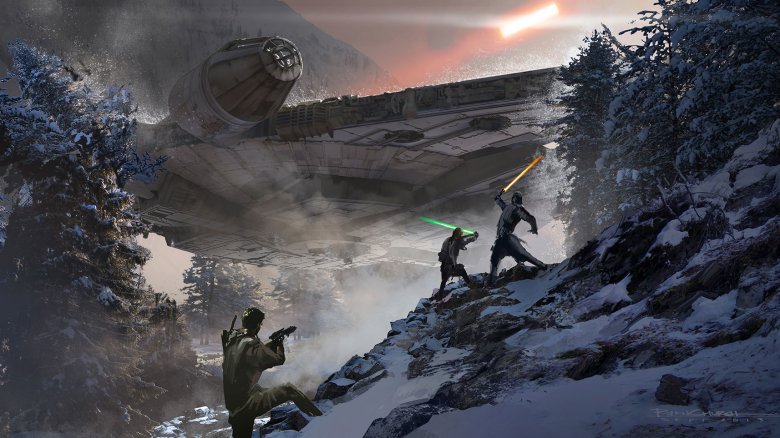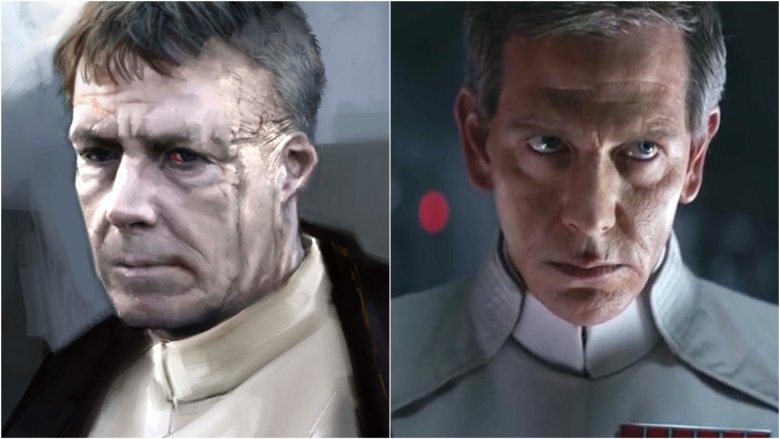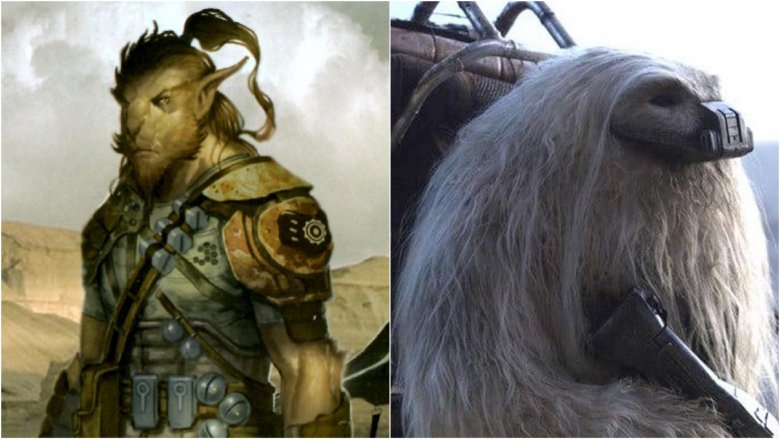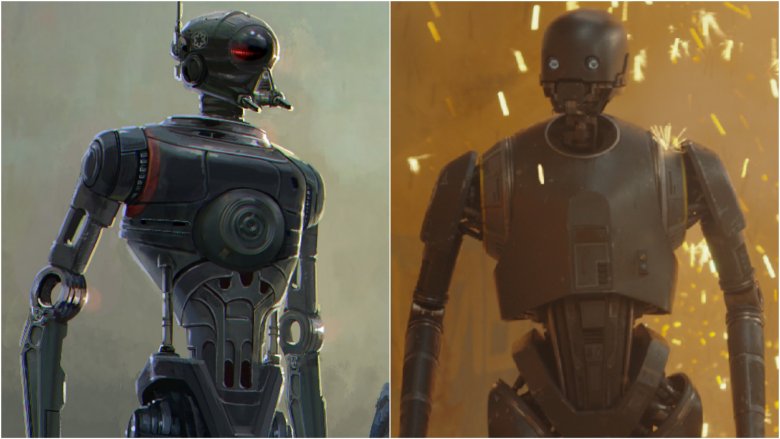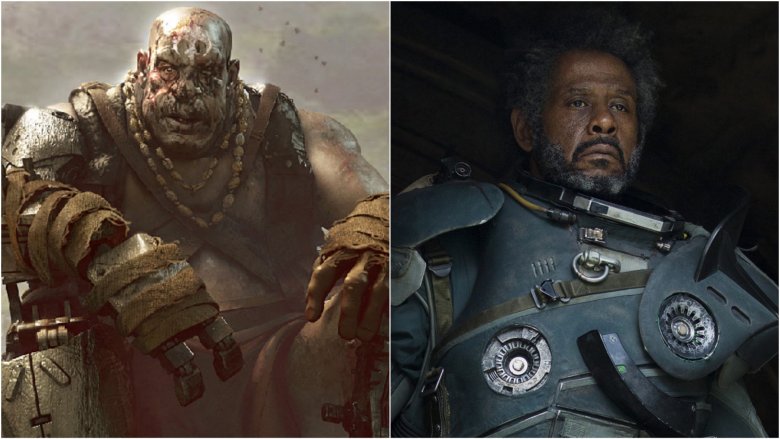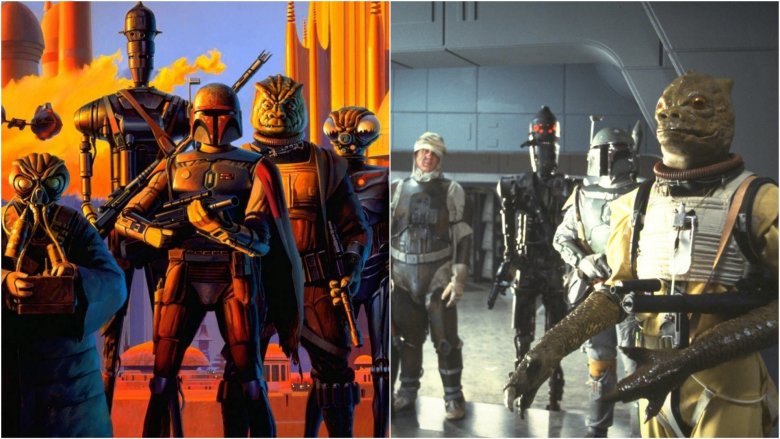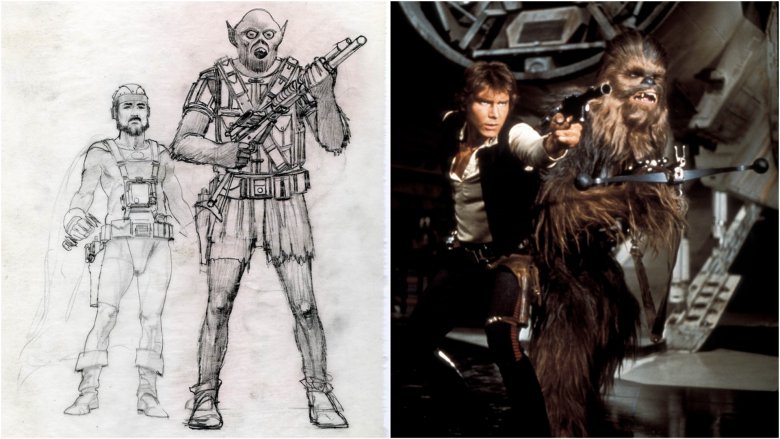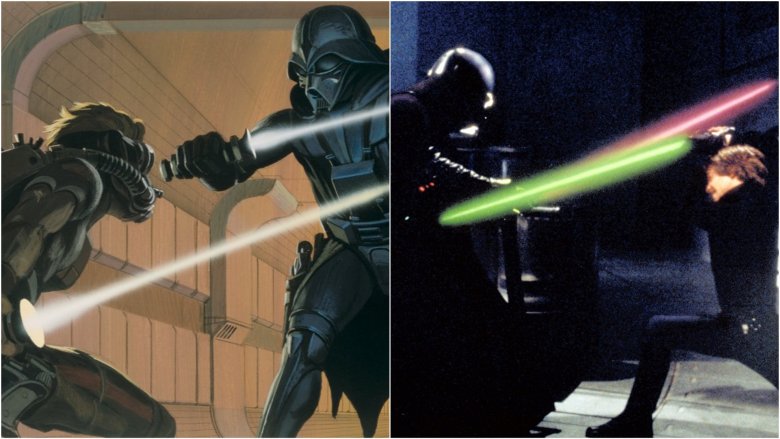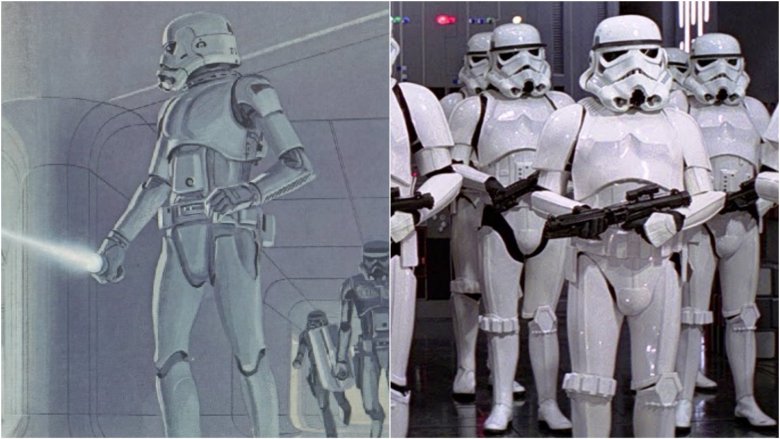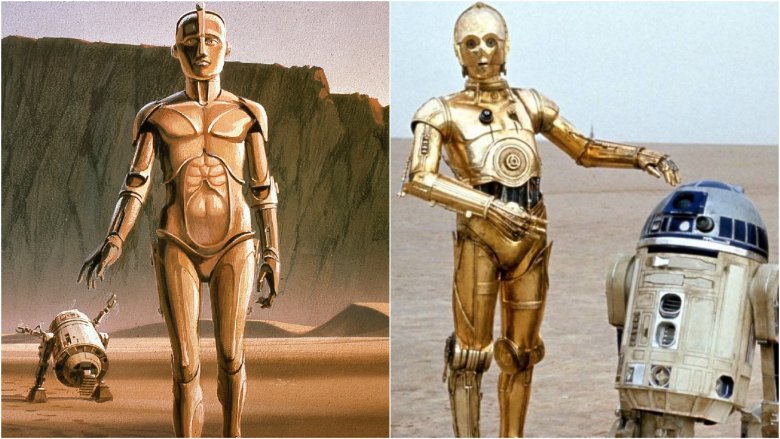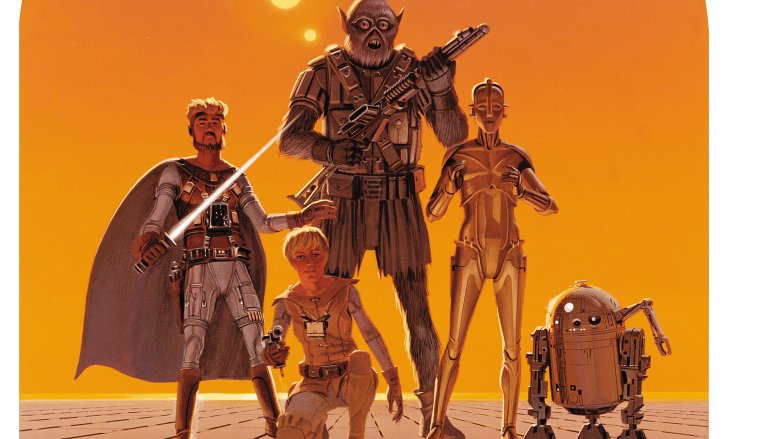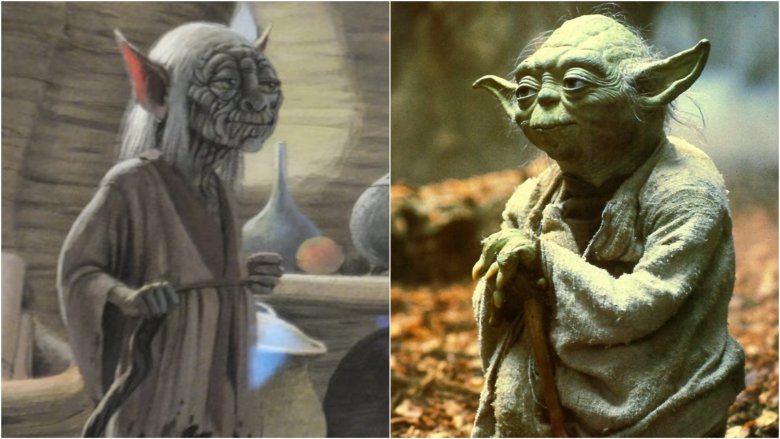Star Wars Concept Art That Will Change How You See The Films Forever
Star Wars is one of the most successful franchises of all time — and the true magic and success behind the series doesn't come from the quantity of content, but the quality. The sheer creativity in the original trilogy that George Lucas started in 1977 captured the hearts and imaginations of millions of people across the globe. It was these vivid characters, captivating light saber duels, fantastical planets, and the intriguing concept of the Force that drew in so many lifelong fans.
These very same fans might be surprised to learn that the characters and settings they love went through numerous design alterations that could have changed the course of the entire series. Some of the concepts Lucas considered, like a female Luke Skywalker or lightsaber-wielding stormtroopers, would have led to the creation of a very different Star Wars cinematic universe. Although many of these ideas never came to fruition, the concept art from the films gives us a peek at what might have been.
Orson Krennic
Orson Callan Krennic, the dastardly Director of the Advanced Weapons Research division of the Imperial Security Bureau and the main antagonist of Rogue One: A Star Wars Story, had several alternate appearances that were first considered. A shrewd and ambitious human male, Krennic oversaw the inception and construction of the original Death Star and was its first commander, although he was usurped by his rival Grand Moff Tarkin after his failure to protect the designs for the superweapon on Scarif.
Some iterations of Krennic tweaked small features, like changing the shape of his hat, while others incorporated completely different ideas that never made it to the film. One particularly interesting version of Krennic depicts the Director with a much paler complexion and some unsettling scarring across his face. This appearance seems to imply that a version of Krennic with a dark and painful past was considered for Rogue One, and starkly contrasts the clean-cut and confident rendition of the Director that was ultimately presented in the film.
Senna (Moroff)
Moroff was a male Gigoran operating during the reign of the Empire who roamed war-stricken planets offering his services as a heavy gunner to the highest bidder. Moroff appeared in Rogue One: A Star Wars Story working as a soldier of fortune for the Partisans, a radical rebel faction led by Saw Gerrera. During his time with the Partisans, he fought in the Jedha insurgency and brought recently defected Empire pilot Bodhi Rook to Gerrera for questioning.
In the film, Moroff is depicted as a large alien covered in white fur wearing a voice translator box over his mouth. Although he ended up playing a very small role in Rogue One, both his appearance and role in the film changed drastically between planning and production. Originally called Senna, Moroff was supposed to join the Rogue One team along with a number of other characters such as Dray Nevis, Ria Talla, and Lunak. Moroff's Wookieepedia page goes into more detail about how the character design inspired two members of the Rogue One team, noting he was "intended to be a duo with the character of Lunak and these two characters ultimately influenced the duo of Baze Malbus and Chirrut Imwe." Senna's physical appearance went through quite a few design changes, involving a reptilian, a wolfish, and an elf-like version. After many changes, the character was eventually renamed Moroff and given a significantly smaller role in the movie.
K-2SO
K-2SO was a KX-series model security droid developed for military use by the Galactic Empire. Also known as enforcer droids, the KX-series was manufactured by Arakyd Industries to protect Empire VIPs and guard Imperial bases. K-2SO however, was reprogrammed to serve the Rebel Alliance by Captain Cassian Jeron Andor after a struggle ensued between the two of them on the planet Wecacoe. It took several attempts, but Cassian was finally able to erase the security droid's memory and reprogram it.
Surprisingly, the initial concept art for K-2SO bore a striking resemblance to C-3PO. Not only did K-2SO have a similar shape to the protocol droid, the two had almost identical chestplates and similarly articulated navels — in fact, other than color, the main noticeable difference between C-3PO and early sketches of K-2SO is the replacement of mechanical eyes with a more intimidating Vader-style visor. Of course, the version that ended up onscreen was still imposing.
Saw Gerrera
Saw Gerrera was a ruthless warrior and military tactician who protected his homeworld from invasion and occupation during a number of different conflicts. Gerrera participated in the Clone Wars, the Onderonian Civil War, and commanded a group of Onderonian rebels during the reign of the Empire. The brutal tactics Gerrera employed against the Empire were considered too radical by the Rebel Alliance, so he formed an extremist rebel faction known as the Partisans who utilized terrorist strategies to disrupt Imperial military operations.
Although Gerrera appeared in Rogue One as a human male (played by Forest Whitaker), the original design seemed to imply he was some type of large grayish-colored alien. This version seems even more intense and intimidating, especially considering the massive pile of stormtrooper masks he's resting on. Some features from the original design, such as the mechanical legs, were carried over to Whitaker's portrayal of the character, but other aspects of this concept art, such as the upside down Rebel Alliance tattoo on Gerrera's forehead, never made it onscreen.
Bounty hunters
The bounty hunters of the Star Wars universe have always consisted of some of the most intriguing characters in the galaxy. An excellent example of this is Boba Fett, who managed to capture the heart of millons despite having less than 20 minutes of screen time throughout the entirety of the original trilogy. Ralph McQuarrie, a legendary conceptual illustrator who helped George Lucas design practically every character and planet seen in the early Star Wars movies, first visualized the bounty hunters that Darth Vader summons in The Empire Strikes Back to track Han Solo and the Millennium Falcon in the concept art seen here.
Titled "Bounty Hunters in Cloud City," this McQuarrie painting depicts some of the most feared bounty hunters in the galaxy including (from left to right) Zuckuss, IG-88, Boba Fett, Bossk, and 4-LOM. Dengar is the only bounty hunter excluded from this picture who was also hired by Vader to locate the Millennium Falcon.
Han Solo and Chewbacca
Several other sketches from Ralph McQuarrie help offer glimpses into how Han Solo and his trusty Wookiee sidekick Chewbacca were conceived. Han Solo was a human male smuggler from Corellia who, along with his faithful Wookiee co-pilot Chewbacca, became an integral part of the Rebel Alliance during the Galactic Civil War. His contributions to the war range from assisting in the destruction of the first Death Star to the Battle of Yavin.
Since Han Solo and Chewbacca are two of the most iconic and recognizable characters in the series, it certainly is strange to see such unfamiliar renditions of the smuggler and his Wookiee pal. One rough sketch of Chewbacca has significantly less hair and seems more ape-like than his conventional appearance. A few of these early Han sketches barely resemble his onscreen counterpart, instead depicting the smuggler with a bushy beard and completely different hairstyles.
Luke Skywalker and Darth Vader
Perhaps one of the most famous pieces of Ralph McQuarrie concept art, "Luke versus Vader" portrays a clash between two of the most powerful force users in the galaxy. This painting is one of the very first visualizations of Darth Vader, and was one of the illustrations that Lucas used to pitch his idea of a galaxy far, far away to studio executives. Although most critics and fans have settled on calling the painting "Luke versus Vader," Ralph referred to it as "the Laser Duel" since Lucas first described lightsabers to him as laser swords.
Incredibly, this draft of Darth Vader isn't too far off from the iconic villain later depicted in the films. Only a few minor differences, such as his white lightsaber, the proportions of Vader's helmet and the inclusion of a more jagged cape, are noticeable from the polished character seen onscreen. On the other hand, Luke Skywalker evolved from a completely separate character. In the painting, Deak Starkiller, the first iteration of the main protagonist, is shown wielding a yellow lightsaber and appears to be wearing some type of respiration equipment and goggles. It was the creation of this scene that inspired the way Vader ultimately looks, as McQuarrie suggested that Vader could utilize a breathing apparatus to jump from ship to ship in the unforgiving vacuum of space.
Stormtroopers
Ralph McQuarrie primarily created this painting in 1975 in order to display the armor he'd developed for stormtroopers, but it also offers insights into some conceptual ideas that were changed or discarded for the film.
The most glaring example of a detail that was changed is the weapons wielded by the stormtroopers. Not only are several troopers in the background carrying large shields, but one is even armed with a lightsaber. Since lightsabers are wielded primarily by Force users in the films, it's shocking to see a run of the mill stormtrooper using one. McQuarrie reflected on this as a purely pragmatic decision, explaining, "I gave Han Solo a lightsaber, and I thought it was reasonable to assume the opposing forces would have the same weapons." The Star Wars universe would no doubt be completely different if every smuggler and trooper wielded lightsabers instead of blasters. Restricting lightsabers to the Jedi and Sith gives these characters an added mythical element.
C-3PO and R2-D2
C-3PO and R2D2 first came to life in the 1975 production illustration Ralph McQuarrie titled "Artoo and Threepio leave the pod in the desert." Although R2D2 looks fairly similar to the final version of the astromech in the films, the design of C-3PO definitely went through some changes and tweaks. The famous protocol droid was modeled after the robot in the film Metropolis, except Lucas told McQuarrie "let's make him a boy." The original sketch for C-3PO incorporated a completely different torso and a much more humanistic face. Apparently McQuarrie struggled with designing the droid's face until John Barry suggested adding a pair of round eyes for an astonished look.
According to McQuarrie, Lucas first described R2-D2 to him as "a kind of repair guy." McQuarrie took this idea to heart when designing the plucky little astromech, outfitting him with various tools and utility arms. Another interesting tidbit about this illustration is a small dispute over McQuarrie's inspiration for the backdrop. Carol Wikarska, Lucasfilm's director of publications at the time, said he used the Oregon coast as a source; however, many adamant fans insist that the background more closely resembles Morro Bay, California.
The original trilogy heroes
This rendition of the main protagonists from the original trilogy was created by McQuarrie in April 1975. Since this illustration was designed between Lucas' second and third draft, the main characters were still being workshopped. At the time, Lucas was apparently considering making Luke a female. Aside from that, this concept art has an interesting strange twist to it: Han Solo, wearing a cape reminiscent of Lando Calrissian, is armed with a lightsaber, while the female version of Luke wields a blaster pistol.
This iteration of the original trilogy squad could have evolved in a completely different film, with Luke and Leia meshed into a single character and Han Solo possibly being the Force-sensitive youth training to become a Jedi. The versions of C-3PO, R2-D2, and Chewbacca in this poster look familiar to some of McQuarrie's early drafts of the characters. A detail worth noticing here is the striking resemblance between McQuarrie's first drafts of Chewbacca and a character that was later introduced in the television show Star Wars Rebels by the name of Garazeb Orrelios. Orrelios was a male Lasat, tall and hairy creatures that have very similar figures, clothing, and faces to the early drafts of Chewbacca. It's very likely that McQuarrie's designs were repurposed or helped to inspire the creation of the Lasats.
Yoda and Dagobah
Yoda, another one of the most iconic Star Wars characters of all time, was also brought to life by the late and great McQuarrie. After their success working together on the characters, vehicles, and settings in A New Hope, Lucas contacted McQuarrie to help him continue to expand the Star Wars universe for the sequel. Much of McQuarrie's concept art for The Empire Strikes Back influenced the final version of the film, particularly his sketches of Yoda and his planet of exile, Dagobah.
Since this illustration is one of the very first drafts of Yoda, the wizened Jedi master had several different features that were tweaked before the character made his debut onscreen. For example, this iteration of Yoda is noticeably leaner, and has pointed ears that tilt upwards as opposed to the horizontal and slightly asymmetrical appendages he ended up with in The Empire Strikes Back. This concept art also depicts Yoda with what appears to be tiny scales across his face, instead of the wrinkled green skin he has in the films. Aside from a first look at Yoda for costume designers, this illustration offered set designers a glimpse into his hut on Dagobah. The walls of packed mud and tapering pillars that McQuarrie sketched all ended up onscreen.
